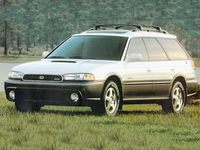New Car Review
1995 SUBARU LEGACY OUTBACK WAGON
by: CAREY and BILL RUSS
SEE ALSO: Subaru Buyer's Guide
Sport-utility vehicles are the hot items in the auto industry today, with rapidly increasing popularity and sales. They are fashionable and trendy. Although most are highly capable off of paved roads, few are used in such a manner. They are used primarily as alternatives to station wagons and minivans, particularly where slippery winter conditions abound. This is fine, but most sport-utes do have some basic practical disadvantages. They are heavy and so require a large engine with consequent poor fuel economy. Sport-utilities can be quite expensive - $30,000 or more is not uncommon. And, despite all of the luxury features and amenities, sport- utility vehicles are trucks at heart. For people who need all-weather abilities and don't need or want a truck, Subaru has an alternative to the alternative - the Outback wagon.
The Outback is the latest in a long, proud line of all-wheel drive Subaru station wagons and is basically a special option package on a Legacy wagon. Subaru all-wheel drive cars and wagons have long been very popular with people who live where ice and snow are common - people who really need the benefits of all-wheel drive as opposed to sport-utility style. All- wheel drive has handling benefits in fair weather as well as foul, so Subarus can be as useful in subtropical Florida as in a Minnesota winter. All Legacy models sold in North America, including the Outback, are made at the Subaru-Isuzu Automotive plant in Lafayette, Indiana, and about 70 percent of the parts and materials used in the Legacy models are of U.S. origin.
APPEARANCE: The Legacy AWD has been restyled for 1995 and is now slightly larger. The new Outback model is a more aggressive-looking version of the Legacy station wagon. It features a special two-tone paint scheme that is body color on top and silver-gray below the belt line and over the wheel arches. A roof rack, projector-beam fog lamps, and special alloy wheels with Bridgestone Potenza P195/60HR-15 all season radial tires add to the usefulness and appearance of the Outback package. Similarly, the plastic-coated 5 mph bumpers, the black grille, and window trim and the large side view mirrors hint at practicality and safety.
COMFORT: The Outback is equipped with all of the features of the mid-range Legacy L wagon and adds special cloth interior trim, a cargo area tray, and an extra 12-volt power outlet in the cargo area as well as a roller shade cover. It has plenty of space for four adults, or, more in keeping with its intended mission, two avid outdoors types and lots of camping gear. The front bucket seats are supportive, while the rear ones fold down 60/40, and can be folded flat for more cargo area. Instrumentation is good, the heater/air conditioner is efficient, and the AM/FM/cassette sound has excellent fidelity. The interior is quiet with little wind noise, and visibility is excellent due to the large window area.
SAFETY: Safety has always been one of Subaru's strong points, and the Outback is no exception. It is equipped with dual air bags, anti-lock four wheel disc brakes, 5-mph bumpers, side guard door beams, front and rear crush zones, and full-time four-wheel drive.
ROADABILITY: Subaru's niche in the automotive market of the nineties is to make cars featuring full time all-wheel drive together with four-wheel anti-lock disc brakes. The Outback is a good example of a car so equipped. It proved itself well on twisty roads in slushy snow, as well as crusty ice, rainy streets, interstate highways, and even dry pavement. The Outback is equipped to go on any sort of road in almost any kind of weather or road condition. Its new chassis is stronger and its ride qualities are now more precise. It stops straight and true.
PERFORMANCE: Subaru uses its time-proven horizontally opposed, four-cylinder, 16-valve, single overhead cam, multiport fuel injected, distributorless ignition engine in the Outback as well as other Legacy models. This sophisticated 2.2 liter engine develops 135 horsepower and 140 lb/ft of torque, and is matched with an electronically controlled four-speed automatic transmission with an overdrive lockout. When climbing or descending steeper grades we found it best to keep the transmission in third gear for better control. With power delivered to the wheels that need it the Outback remains quite stable.
CONCLUSIONS: The Outback is designed for those folks who need a car than is capable in almost any terrain and weather. It has more car-like qualities than the truck-based sport utilities and vans, and is less expensive to buy, insure, and operate. The Subaru Legacy may not be as American as apple pie, but it has a lot going for it.
SPECIFICATIONS:
1995 SUBARU LEGACY OUTBACK WAGON
Base Price $ 19,820
Price As Tested $ 21,664
Engine Type H-4, horizontally opposed, 16 v sohc, mpfi
Engine Size 2.2 liter/135 cid
Horsepower 135 @ 5400
Torque (ft/lbs) 140 @ 4400
Wheelbase/Length 104"/184"
Transmission four-speed EC automatic w/overdrive
Curb Weight 3100 lbs.
Pounds per Horsepower 22.9
Fuel Capacity 16 gal.
Fuel Requirement Unleaded regular (87 oct)
Tires Bridgestone Potenza RE92 all-season
P 195/60R 15 87H
Brakes vented disc/disc, ABS standard
Drive Train Front engine/full time all-wheel drive
PERFORMANCE
EPA Economy - miles per gallon
city/highway/observed 22/28/27.4
0 to 60 mph 8.2 sec
1/4 mi (E.T.) 16.4 sec
Coefficient of Drag (Cd) .35



